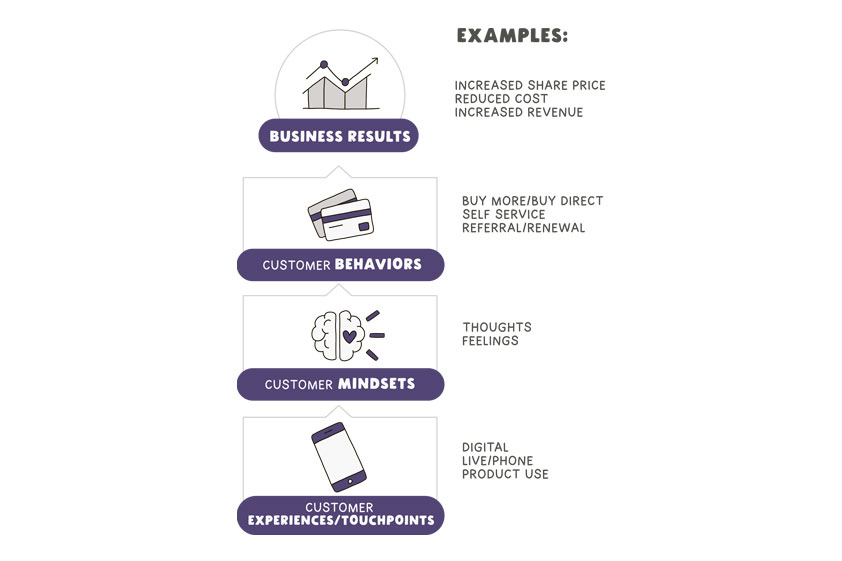Insights | By Howard Tiersky
WHY YOUR SENIOR EXECUTIVES ARE STILL NOT SOLD ON “CUSTOMER CENTRICITY”
Even if you are already convinced that it’s important for your company to be customer-centric, you still need a strong business-minded answer as to why—because you will need to persuade others.
And while most of the business leaders you will need to persuade will be quick to give “lip service” to the idea of being customer-centric, many will resist actually doing it.
THE PERSUASION SCENARIO
Let’s consider the typical “persuasion scenario” that must be overcome for a company’s management to commit to becoming truly “customer centric.”
The people who are responsible for a business’ “bottom line”— CEOs, CFOs, boards of directors—tend to have a certain point of view about the customer, and it goes like this:
They want customers, absolutely. They always want more customers, bigger customers, and more “loyal” customers. Everyone agrees that customers are very, very important to the business.
And when you say you want to focus on improving the customer experience, you generally get a lot of agreement. After all, who can argue against that? The customer is critical.
We want them to have a “good experience.” Sounds nice. You may even be able to convince the executives that a better experience will make customers love you more, which also sounds nice.

IT COSTS HOW MUCH??
However, when you then say that you need $2 million or $20 million or $200 million to redo the apps, the e-commerce system, stores, whatever it may be, to give the customer a better experience, you often get a different response. You may hear something like,
“Hmmm, well as we said, we definitely care about the customer; we really do…But we are also running a business. Every dollar we spend comes right out of our profit.
“Customers today are still doing business with us based on today’s experience. Of course, it’s good to make it better, but how good does it need to be?
“If we spend all this money improving the customer’s ‘experience,’ how do we know if we will get that money back? Maybe if we leave it as it is, our customers will still give us their money, and that would be cheaper, after all…
“Because if we spend all that money and make it better, customers will probably be happier, and they might love us more, and even give us some more money, but they might not give us enough more of their money to justify the cost of improving the customer experience.
“Maybe we are better off keeping the majority of that money as profit while just making a few token improvements.”
It is this, only slightly caricatured, line of thinking that kills many potential beneficial investments in customer experience.

BUILDING THE CASE FOR CUSTOMER CENTRICITY
There are a variety of statistics showing that the companies that give their customers a better experience and are more digitally savvy are generating more revenue growth, more profit, and higher valuations.
That data will be a useful start in making the case for funding, so start there, but it might not be enough. Those stats just show correlations; they don’t necessarily explain why investing in better digital customer experience is worth it.
Sometimes, when decision makers don’t understand the logic, even statistics don’t get you there.
So it’s important to deeply understand the causality between experience and business results, both so as to be more persuasive and also because there are an infinite range of ways one could invest in improving the customer’s experience—send customers gifts, carpet the store, create funny videos, offer them fresh coffee, give the app a facelift, add augmented reality, etc. You can’t do it all.
You’ll need to figure out which ways of investing in customer experience will drive the greatest bottom line results.
If you tangibly understand exactly why better customer experience results in better business—how one thing drives another and then leads to dollars—you are in a better position to figure out which changes will be the most worthwhile.
PUSHING BUSINESS LEVERS IN THE RIGHT DIRECTION
Businesses generally exist commercially for two reasons: to generate a profit and to make the business more valuable, such as raising the stock price or raising the valuation that someone would use to buy or invest in a private business.
So, increasing profit and business value have to be strategic goals of pretty much any investment.
You will misalign with the fundamental mindset of most executives if you make it seem like the end goal is to make customers happy.

But, if we can effectively achieve our strategic goals via making customers happy and meeting their needs, then we have a wonderful ecosystem where we are doing good and doing well.
Personally, what gets me out of bed in the morning is creating great experiences for users, not raising the stock price of a company.
But for customer experience investments to be justified and sustainable at for-profit companies, we need to be able to demonstrate that these two are connected.
So here’s how they are connected. Consider what it is that drives share price: it’s largely business profitability and beliefs about future profitability.
The value of most traditional businesses is primarily calculated based on how much profit it’s generating and how much it’s expected to earn in the future.

So what drives business profit? Well, profit is simply revenue minus cost; so things that increase revenue and reduce cost are what drive profit.
We often call these factors that increase revenue and reduce cost “business levers.”
COMMON LEVERS THAT INCREASE REVENUE INCLUDE:
- New customer acquisition
- Customer retention and renewal
- Upsell and cross-sell
- Ability to increase price or reduce discounting
COMMON LEVERS THAT DECREASE COST INCLUDE:
- More cost-effective manufacturing
- Reduction in customer service costs because customers are using self-service
- Reduction in sales costs because customers are shopping or ordering digitally
- Reduction in marketing costs due to customer advocacy
- Getting customers to buy directly from you, avoiding distribution channel costs
Most business stakeholders will readily agree that moving these levers in a positive direction is how the company will increase its profit and, ultimately, its value. This part is not controversial.

But here is the critical link that can become a powerful idea to “connect the dots” for senior management.
There is one key factor that cuts across most cost and revenue levers: customer behavior.
If the customers do what we want them to do, we push the levers in the direction we want (more revenue, less cost).
If the customers don’t do what we want, or they do the opposite, we push the levers in the wrong direction.
Influencing the behavior of customers and prospects in a strategic direction is the single most impactful way to move business levers and, therefore, achieve business success.
HOW TO MAKE YOUR CUSTOMERS BEHAVE
So how do you do that? What is it that causes customers to behave in a certain way?
PEOPLE BEHAVE ONE WAY OR ANOTHER
BECAUSE OF THEIR THOUGHTS AND FEELINGS.

Let’s take a customer who is considering buying a new car. He has feelings about certain brands or certain car dealerships.
He has thoughts about how much he can afford to spend and feelings about how his wife will react to how much he spends.

When he sits in the car, he has one feeling. When the salesperson sits him down at the desk and goes over the terms, he has various other thoughts and feelings.
The combination of his thoughts and feelings are 100% of what triggers his ultimate behavior.
So, if we can figure out which thoughts and feelings will trigger the behaviors that we want—the ones that push our business levers in the right direction—that would presumably be very valuable. Maybe.
“Maybe,” because it’s only useful to know those thoughts and feelings if you have some means to impact them.
But while marketing technology has not advanced to the point where we can directly implant thoughts and feelings in our customer’s consciousness (though someone is probably working on it), we do know what creates thoughts and feelings: experiences.
As a demonstration, think about a feeling you felt recently. Where did it come from? Did you see a puppy and feel happy? Did you stub your toe and feel angry?
Did you watch a movie and feel scared? Did you remember a fight you had with your mother 30 years ago and feel remorse?
Feelings come from experiences most of the time—either experiences in the moment or remembered experiences or sometimes imagined experiences.
Of course, not everyone responds with the same feelings to a given experience, but the key point is that it’s experiences that create feelings.
And where do thoughts come from? From things you learned, from things you saw, from things you heard or tasted.
Thoughts largely also come from the amalgam of your experiences and the conclusions you have drawn from them.
THE STRATEGIC CUSTOMER EXPERIENCE MODEL
If experiences create thoughts and feelings, and thoughts and feelings ultimately connect to the behavior that drives business results, then getting the experience right is essential.
Now, technically, we can’t actually create experiences for people. People create their own experiences.
But we can create touchpoints—a store, a website, a mobile app—and through their interactions with those touchpoints, people have experiences, and this is the root of the opportunity. See this illustrated in the diagram below.

Of course, just as not every person has the same feelings or thoughts when given the same experience, not everyone has the same experience when interacting with the same touchpoint.
One person goes to a store to buy dishes, finds a set he loves, has an easy checkout experience, and is happy. Another person can’t find what she likes, feels the prices are too high, and talks to a rude salesperson.
In both cases, their thoughts and feelings from the experience ripple forward to their behavior, some of which will push the store’s business levers, which will then lead to positive or negative consequences for the business’ results.
So, when we talk about creating a “user experience” or a “customer experience,” we are generally talking about creating the touchpoints, the interaction with which will result in the user having an “experience.”

Or even more accurately, customers will usually interact with a series of touchpoints over time. They might go to your website and then drive to your store.
While in the store, they may use your mobile app, and perhaps, a kiosk. When they get home, if they have a problem, they may call your call center or use your chat feature.
Later, you may email them, text them, or send them something in the mail, and one of those may inspire them to come back to the store or shop on the website, and the cycle continues.
This series of interactions, or experiences, is what we mean when we speak of a customer journey.
When a customer journey results in far more positive emotions than negative ones, when the customer thinks and feels that the brand is meeting their needs consistently and even occasionally giving them that delightful feeling of surprise when their expectations are exceeded, and when the experience is aligned with the customer’s values, then we have the right ingredients to inspire the love that is so valuable to long-term business results.

I talk extensively about this strategic customer experience model in my Wall Street Journal bestselling book, WINNING DIGITAL CUSTOMERS: THE ANTIDOTE TO IRRELEVANCE. It will show you exactly how you can use and optimize this model to create amazing customer experiences that will actually make your business more profitable. The first chapter of the book is downloadable FREE at this link https://WinningDigitalCustomers.com.











